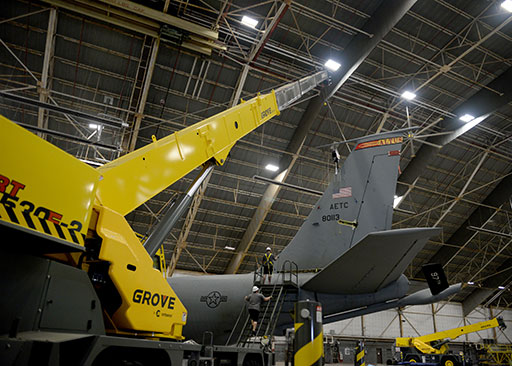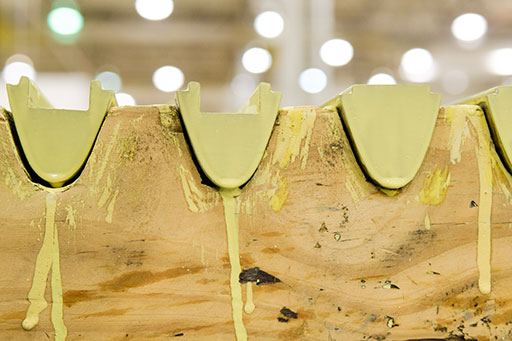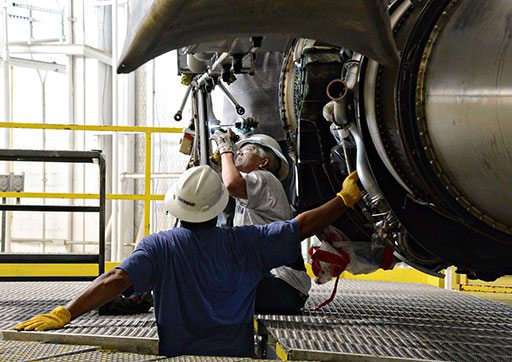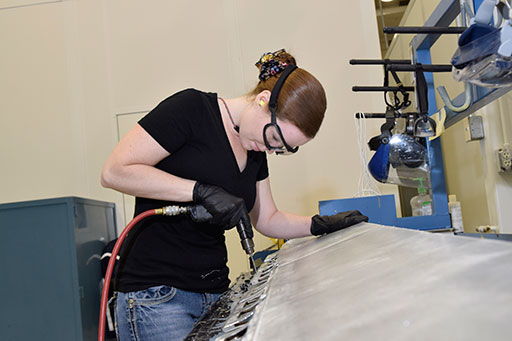Providing depot level maintenance for more than 500 U.S. Air Force (USAF) aircraft operating worldwide is a mammoth operation, spearheaded by Tinker Air Force Base (AFB) just outside Oklahoma City.
Providing MRO services to the wide range of aircraft operated by the United States Air Force (USAF) requires a very sophisticated, and well regulated, operation. Add the fact that the majority of the aircraft being maintained such as the Boeing B-52 are 50 to 60 years old, and it becomes even more impressive.
The Air Force Sustainment Center (AFSC), based at Tinker AFB and commanded by Lt. Gen. Lee K. Levy II, provides the overall management of this depot level maintenance, what the Air Force calls ‘execution and consolidation oversight of maintenance, supply chain activities and installation support.’
Falling within the AFSC is the Oklahoma City Air Logistics Complex (OC-ALC), the largest of three Air Logistics Complexes for USAF aircraft, concentrating on Boeing KC-135s, B-52s, B-1, E-3s and Northrop Grumman B-2s. The two others Air Logistics Complexes are Robins AFB in Georgia, providing depot maintenance on the Boeing F-15 Strike Eagle and C-17 Globemaster , Lockheed Martin C-5 Galaxy and C-130 Helcules, KC-10 and SOF aircraft, and Hill AFB, Utah, which handles maintenance for the Lockheed Martin F-35 and F-22, General Dynamics F-16, Fairchild A-10 and Northrop T-38.
The 76th Aircraft Maintenance Group is a key part of the OC-ALC, providing the blue collar, hanger floor maintainers who do the maintenance. The OC-ALC also includes the 76th Propulsion Maintenance Group responsible for depot level maintenance for Air Force and Navy aircraft engines. The 448th Supply Chain Management Wing, responsible for ensuring that the necessary spares are available as needed, is also part of the responsibilities of the AFSC.
The three elements, consisting of the AFSC, 76th and 448th, get together once a year for a requirements review and depot determination (or R2D2) meeting to develop “one big list of what they’re expecting for the next two years,” according to Steve Alsup, director of logistics for the AFSC, or AFSC-LG. “They then use that input to help scope and shape the size of their workforce for those coming years. As our workforces expand and contract based on the nature of the work that we have coming down the pike, this process has never been more important,” he said.
The aircraft themselves are managed under the Air Force Lifecycle Management Center (LCMC). The LCMC program office for the particular aircraft type will monitor the aircraft and decide when it is time to come in for maintenance — normally about every five years.

(U.S. Air Force Photo by Airman 1st Class Jackson N. Haddon/Released)
These program offices track the maintenance activities of the aircraft and look for trends, Alsup said: “If we’re starting to see the same thing break over and over, maybe we need to modify our processes to meet the warfighter’s need.”
The OC-ALC handles over 100 aircraft a year, with the majority being the KC-135, according to Wade Wolfe, the organisation’s vice director. His unit does some $3.4 billion worth of work a year, with just over 9,800 employees.
“We do in excess of 70 KC-135s a year, about 17 B-52s, about 10 or so B-1s and two or three E-3s,” he said. He also is responsible for repairs on over 500 engines per year.
The vast majority of the maintenance work is done by Department of Air Force civilians. Out of 8,176 maintainers, only 97 are military.
Management of the hangar floor maintenance operations is aided by a new computer system being added called the Lean Depot Management System (LDMS). “This new software is a totally self-contained system that the complex will use to help me with bills of materials, what we refer to as bonds, schedule items in for maintenance, help us order the material, help establish pick lists for parts required and help with our kitting processes.”
Wolfe has over 1,000 software engineers to develop the software for the maintenance program. “OC-ALC workload is growing, and should double over the five years,” he said. The software engineers write code for the different systems on the various aircraft maintained at the center. He noted that weapon system software has grown exponentially over the years. “For example, the B-2 was first fielded with 1.5 million lines of code, versus the (incoming) KC-46, which is estimated to have 15 million lines of code.”
Alsup noted that the computerization that runs his wristwatch “could probably have run a B-52 thirty years ago.”
Perhaps the biggest challenge facing the maintenance center is aging aircraft. Within the next couple of years, the USAF will be introducing the Boeing KC-46, a heavily modified Boeing 767, into it fleet. The first aircraft is scheduled to enter service next year and arrive at Tinker for the first C-Check in 2019. The Air Force C-Check is very light, consisting of 373 tasks, Alsup said. New maintenance hangars are already under construction, and a large part of the software for the KC-46 is commercial-based, with the AFSC partnering with Boeing, he added.
But in the meantime, Tinker is providing maintenance for KC-135s and B-52s that are over half a century old. Engineering studies have shown that the B-52 could keep flying into the 2040s and beyond, leading to speculation that the giant bomber could reach the 100-year-old mark. And with the half-century-old aircraft, the problem becomes simply finding the parts. A section of a B-52 is opened and a part that has never needed to be replaced suddenly is.
Another problem comes when a part is needed for a ‘low-density’ aircraft, such as the B-2, with only 20 being supported.
Spare parts to keep the Air Force’s aircraft flying are the responsibility of the 448th Supply Chain Management Wing. Parts are ordered up to two years in advance under a $5.3 billion budget, according to Frank Washburn, the Wing’s director.
About 80 percent of the parts used are sourced through repairs rather than new-buys, with most of the repairs done in-house and the rest by outside contractors. Not all of those parts go into Tinker. Roughly 70 percent go to operational units, with only about 30 percent going into depot maintenance and engine overhaul programs, Washburn said.

(U.S. Air Force photo/Greg L. Davis)
So a request for bid will be put out for that part. “Then we can get into a situation of what we call ‘no-bid,’ added Washburn. “Nobody wants to bid on making two left-handed widgets for a B-2. They want to make 100, because that’s where the value is. So we have to make a decision whether to go ahead and order 100, giving us a lifetime supply, or find a small company that can reverse engineer the part and build it using new manufacturing techniques such as additive manufacturing (3-D).

As an example, Washburn showed a small fan from a B-52 that would cost about $1,200 if it were all metal. “We leveraged additive manufacturing to be able to make this out of composites and got approval from the program office to be able to use it in B-52s. This little fan spins and cools an instrument in flight. So it’s not flight safety critical, but it is essential to the operational B-52s. This is now being additively remanufactured for $100.” He added that the fan was built by “some little company down in Texas” and is now digitized. “I don’t have to keep these on the shelf any more. It has a little digital label like a UPC label, so I just hit the UPC lever, it sends the signal over to the machine, and the machine makes it.”
Washburn said that additive manufacturing IT is now starting to advance so rapidly “that it quickly replaces what was considered to be next-generation.” Additive manufacturing is even becoming available for metal, although there is still a long way to go. “We want to be able to get to a point where we’re actually additive manufacturing structural parts. Some 20 percent of aircraft grounding conditions caused by problems with parts are because of structural aging. You can really see the impact of aging weapon systems when you look at structural parts as well.”
A key to meeting the needs of these aging weapon systems is going to be innovation, Washburn admitted. The AFSC has created what it calls “Tinker and the Primes.” This is an annual conference bringing together representatives from the three major USAF depot maintenance facilities, as well as industry partners including “hundreds of aerospace, defense and government contracting businesses and organizations.” The next “Tinker and the Primes” is scheduled for August 21-23 in Midwest City, OK.
“What Tinker and the Primes says is that the industry partners across the U.S. will meet here so that our air logistics complex, our supply chain, and our small business and contracting folks can meet with our industry partners to determine how we can innovate together and solve problems that affect the Air Force, whether it be maintenance repair and overhaul, or supply chain,” Washburn revealed.
In the event of the outbreak of combat action, the AFSC has what it calls a ‘surge.’ “We do ‘what if’ scenarios right into our calculator. If we increase flying hours all of a sudden in response to contingency operations, we can determine based on current stock levels that we have across the entire globe how many more of these widgets I am going to need, how many more landing gears, wheels, tires, you name it.” The 448th will then ‘surge’ the supply chain so that industry partners can respond to the new requirement to provide the anticipated spares.

Operational units are also provided with Readiness Spares Packages that they take with them into combat scenarios. “Those are very critical, especially for the first 30 days of intensive operations,” said Washburn. “So in the Afghanistan scenario, if we had to send a unit of A-10s into Bagram, they would take their Readiness Spares Package with them and be able to sustain operations immediately. And with technology the way it is, when they pull a part out of the spares package, I know about it and we can replenishing it.”
